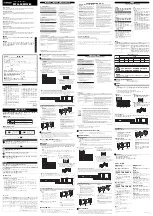
To cover more than one area more efficiently light sensors can be connected in parallel to a light sensor input. An average
value is formed from the individual values of the sensors.
If there is enough daylight available the relevant groups are dimmed to their minimum values and switch off after 10 min-
utes. Unless there is a motion detector these groups remain switched off even if the value falls below the setpoint again
(scene value 1). If there is enough natural daylight (brighter than the lighting level required from the lighting system) and if
scene 1 is called up manually the controller still switches the light to the minimum value. The lighting system remains at its
minimum setting and switches off after 10 minutes, unless the lighting conditions change in the meantime.
Light/movement sensors, presence detection
If one or more motion sensors are connected, the controller will operate for all groups and in all scenes on the basis of
whether or not motion is detected. If no motion is detected during a period of time that can be set on the controller (between
1 and 32 minutes, reset each time motion is detected) the controller will dim the lighting (within about 16 seconds) to its min-
imum setting and then immediately switch it off. If motion is detected within the detection area the lighting system will be
switched on to scene 1. If light sensors are also installed the relevant groups will only switch on if there is not enough natural
daylight.
If motion is detected while the lighting system is being dimmed (before being switch off) the lighting system will be restored
to its last status.
Motion sensors can be connected in parallel to increase the detection area or provide more sensitive monitoring.
Notes on installing light/motion sensors
The light/motion sensors specified in the “Accessories” section can be connected (from one to six light or light/motion sen-
sors depending on the application).
There is one input available for motion detection (three double terminals). All the motion sensors connected here operate in
parallel (extending the detection area).
Depending on the application, the light sensors may all be connected to one LS input or may be apportioned among groups
1 to 3. If more than one light sensor is connected in parallel to the same input the average of the light values detected is take
and used for control purposes.
Light sensor inputs LS1 to LS3 on the controller must not be interconnected.
Where possible, the sensors should be installed in the room so that they point directly to the people or areas they are moni-
toring (ceiling mounting). The room brightness should always be measured indirectly; artificial light should not shine directly
on the sensor.
Motion sensors should not be placed in drafts (near air-conditioning units, heaters, fax machines or printers for example) as
this may cause the sensors to trigger unnecessarily.
To return the system to straightforward open-loop control, disconnect the controller from the power supply and then discon-
nect the sensors.
For further information please refer to the operating instructions for the sensors.
Safety and installation instructions
• Power to the units must be switched off before any work is undertaken.
• The units should be installed and tested only by a qualified electrician.
• Wire the terminals as shown in the wiring diagram. Follow the wiring diagrams and any instructions printed on the units.
• The relevant safety and accident prevention regulations must be observed.
• The unit must not be opened or operated without its casing.
• The relevant installation instructions must be observed.
• Make sure the system complies with the technical data.
• Install into an insulated enclosure only.



































